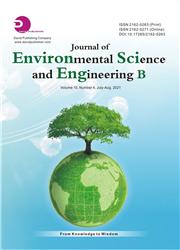Performance of a Modified Trickling Filter Packed with Different Substrates in Polishing Aquaculture Wastewater
引用次数: 3
Abstract
: Sustainable use of natural resources is one of the most critical aspects in today’s world, water monument being one of them. There is a high demand for water in domestic, agricultural and industrial sector. As a result of these there is an increased rate of wastewater generation. To ensure sustainable use of the resource, there is need for wastewater management that will ensure reuse and reduce pollution to the water resource. The aim of the study was to evaluate the performance of different locally available substrate materials in polishing aquaculture wastewater before it is discharged to the receiving bodies and to determine the substrates’ optimal treatment conditions in a modified trickling filter system. The wastewater was characterized with high levels of nitrates, nitrites and phosphates which are nutrients responsible for the degradation of water resources through eutrophication. A modified trickling filter system was fabricated and woodchips, maize cobs and sugarcane bagasse were each packed in three different reactor tanks. These substrates were subjected to similar operating conditions of substrate column heights of 14 cm, 18 cm and 22 cm, varied HRT (Hydraulic Retention Time) at 12 h, 24 h, 48 h and 60 h respectively. Wastewater was collected from a fish pond and passed through the modified trickling filter system for a specified period of time. Samples of the effluent were collected and tested for nitrates, nitrites and phosphates using a UV VIS (Ultraviolet-visible) spectrometer. The results obtained showed that the contaminant with the highest concentration was nitrates. Nitrites was converted into nitrates during the treatment process hence it was not a suitable parameter to be used to make conclusions. Phosphate was present in lower concentrations compared to nitrates hence the desired level was achieved. The most suitable substrate in the removal of all the contaminants was the woodchips with an efficiency of 94% at an operating condition of 18 cm and 22 cm substrate column height for the small and large woodchip particles at 48 and 60 h HRT respectively. Maize cobs and sugarcane bagasse both yielded an efficiency of 92% at 22 cm substrate column height and 60 h HRT .不同基质填料改性滴滤池处理水产养殖废水的性能研究
自然资源的可持续利用是当今世界最重要的方面之一,水纪念碑就是其中之一。家庭、农业和工业部门对水的需求量很大。因此,废水产生的速度增加了。为了确保资源的可持续利用,需要对废水进行管理,以确保再利用并减少对水资源的污染。本研究的目的是在水产养殖废水排放到接收体之前,评估不同当地可用的基质材料在抛光废水中的性能,并确定基质在改进的滴滤系统中的最佳处理条件。该废水具有高水平的硝酸盐、亚硝酸盐和磷酸盐的特征,这些营养物质通过富营养化导致水资源的退化。他们制造了一个改进的滴漏过滤系统,将木片、玉米棒和甘蔗渣分别装在三个不同的反应器罐中。底柱高度分别为14 cm、18 cm和22 cm, HRT分别在12 h、24 h、48 h和60 h时变化。污水收集自一个鱼塘,经过改良的滴流过滤系统一段时间。收集废水样本,并使用紫外可见光谱仪检测硝酸盐、亚硝酸盐和磷酸盐。结果表明,硝酸盐是其中浓度最高的污染物。亚硝酸盐在处理过程中转化为硝酸盐,因此不适合作为得出结论的参数。与硝酸盐相比,磷酸盐的浓度较低,因此达到了所需的水平。最适合去除所有污染物的基质是木屑,在基质柱高度为18 cm和22 cm的条件下,小木屑颗粒和大木屑颗粒在48和60 h HRT下的效率分别为94%。在22 cm底物柱高和60 h HRT条件下,玉米芯和甘蔗渣的效率均为92%。
本文章由计算机程序翻译,如有差异,请以英文原文为准。
求助全文
约1分钟内获得全文
求助全文

 求助内容:
求助内容: 应助结果提醒方式:
应助结果提醒方式:


